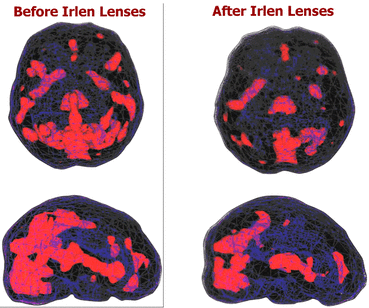Daniel Amen MD Shows Irlen Syndrome Affects
|
Neuropsychiatrist Daniel Amen, MD, Assistant Clinical Professor of Psychiatry and Human Behavior, University of California, Irvine School of Medicine and founder of the Amen Clinics in California, Washington, Georgia, Virginia and New York City, is a pioneer in the field of psychiatry with his revolutionary approach.
Dr. Amen noted that psychiatry is the only medical specialty that treats a part of the body that it cannot see. To change this Dr. Amen started doing SPECT Scans of the brain. Scans of more than 45,000 people have assembled a picture of what many brain conditions look like. Among the recognizable patterns, Dr. Amen has scanned many people with Irlen Syndrome, both before and with Irlen Lenses. The red in the sxans on the left side of the figure to the left indicates areas of brain over-activity. Before Irlen lenses, great areas of the brain of an individual with Irlen Syndrome while reading show over stimulation. In contrast, the pictures to the right of the same person with Irlen Spectral Filters show a significant decrease in this over-activity. Patients of the Amen Clinics that demonstrate this recognized pattern of brain over-activity are recommended to come for Irlen screening. |
Dr. Amen writes about IrlenDr. Amen wrote an edition of his Brain in the News Newsletter about Irlen Syndrome
|
Neuroscientist Dr. Jeffrey LewineDr. Lewine is Professor of Translational Neuroscience at the Mind Research Network, University of New Mexico. He explains how color normalizes brain function for individuals with Irlen Syndrome.
|
|
Research from Cornell University
|
Latest research from Cornell University!
December 5, 2016 Neuroscience Research on Irlen Syndrome at Cornell University From the Desk of Professor Adam Anderson Director of the Affect and Cognition Lab at Cornell University, Ithaca, New York, USA Disorders of reading have been thought to be of primarily phonological origin. However, visual neuroscience has uncovered systematic disturbances in the visual brain in the reading impaired, supporting a prominent role of visual processing deficits. It has been shown that differential processing along three main visual neural pathways: magnocellular, parvocellular and koniocellular, contributes to reading impairments. Each of these pathways has specific wavelength (color) sensitivity, but in combination support all visual processing, beyond the perception of color. As such, changing the background color of visual inputs influences the relative balance between these pathways for visual processing. We and others have shown that such color manipulations enhance and/or suppress the different pathways to influence vision, both in simple tasks, e.g., judging orientations, to complex ones, e.g., reading emotion from faces. Our functional Magnetic Resonance Imaging work at Cornell is following up on these findings to examine how the primary visual cortex relays information along these three visual channels to other regions of the brain to support normal and disordered reading. According to this research, each individual may have altered dysfunction within and across visual channels. As such, unique color filters would be needed to restore normal balance and integration. Based on imbalances in the three pathways we observe in those diagnosed with Irlen Syndrome, we make predictions on what wavelength filters would be most likely to restore normal integration across channels. We then test how use of specific wavelength Irlen filters restore normal visual responses across the three pathways and their relation to visual performance, including reading. More than a simple outcome, like reading speed, we test a specific neural model of dysfunction of the visual pathways involved in reading and its relation to many aspects of vision, reading facility and comprehension, and associated behaviors (e.g., eye scanning) which contribute to a larger syndrome of visual stress and reading difficulty. Sincerely, Adam Anderson, PhD Director, Affect and Cognition Lab Associate Professor Cornell University, Ithaca, NY |
(Copyright © 1998-2015 by Perceptual Development Corp/Helen Irlen. All rights reserved.)



